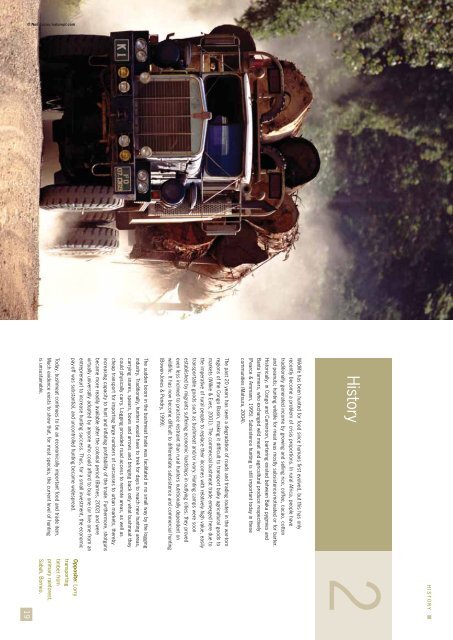Recipes for Survival_English_tcm46-28192
Recipes for Survival_English_tcm46-28192
Recipes for Survival_English_tcm46-28192
- No tags were found...
You also want an ePaper? Increase the reach of your titles
YUMPU automatically turns print PDFs into web optimized ePapers that Google loves.
HistoryWildlife has been hunted <strong>for</strong> food since humans first evolved, but this has onlyrecently become a problem of crisis proportions. In rural Africa, people havetraditionally generated income by growing and selling rice, coffee, cacao, cottonand peanuts; hunting wildlife <strong>for</strong> meat was mostly subsistence-motivated or <strong>for</strong> barter.Historically, in Congo and Cameroon, bartering existed between Baka pygmies andBantu farmers, who exchanged wild meat and agricultural produce respectively(Pearce & Ammann, 1995). Subsistence hunting is still important today in thesecommunities (Matsura, 2004).The past 20 years has seen a degradation of roads and trading routes in the war-tornregions of the Congo Basin, making it difficult to transport bulky agricultural goods tomarkets (Wilkie & Eves, 2001). The commercial bushmeat trade emerged here due tothe imperative of rural people to replace their incomes with relatively high value, easilytransportable goods such as bushmeat and/or ivory. Hunting camps were soonestablished by migrants suffering economic hardships in outlying cities; they provedeven less inclined to practice restraint than rural hunters nutritionally dependent onwildlife. It has now become difficult to differentiate subsistence and commercial hunting(Bowen-Jones & Pendry, 1999).The sudden boom in the bushmeat trade was facilitated in no small way by the loggingindustry. Traditionally, hunters would have to trek <strong>for</strong> days to reach new hunting areas,carrying snares, spears, bows and arrows and bringing back only what bushmeat theycould physically carry. Logging provided road access to remote areas, as well ascheap transport <strong>for</strong> importing large numbers of carcasses to urban markets, therebyincreasing capacity to hunt and inflating profitability of the trade. Furthermore, shotgunsbecame more readily available after the colonial period (Barnes, 2002) and werevirtually universally adopted by anyone who could af<strong>for</strong>d to buy one (or hire one from anentrepreneur) to increase hunting success. Thus, <strong>for</strong> a small investment, the economicpay-off was substantial, and uncontrolled hunting became widespread.Today, bushmeat continues to be an economically important food and trade item.Much evidence exists to show that, <strong>for</strong> most species, the current level of huntingis unsustainable.HISTORY2Opposite: Lorrytransportingtimber fromprimary rain<strong>for</strong>est,Sabah, Borneo.19© Neil Lucas/naturepl.com


